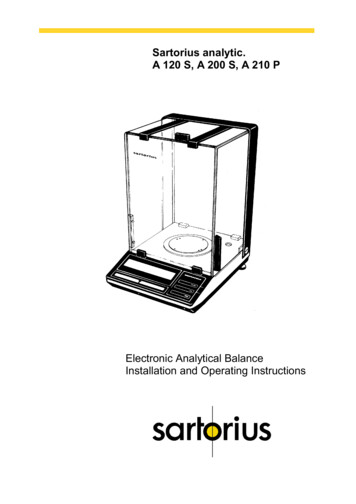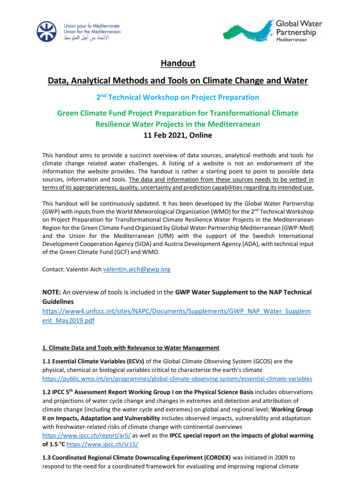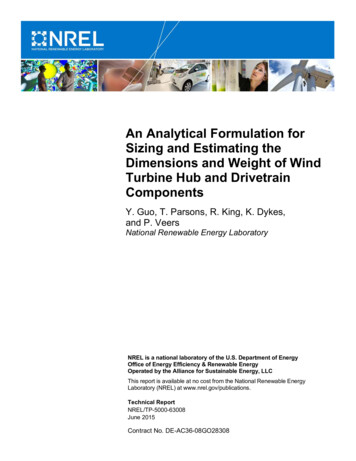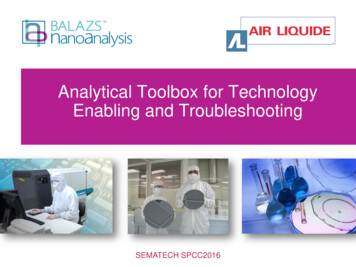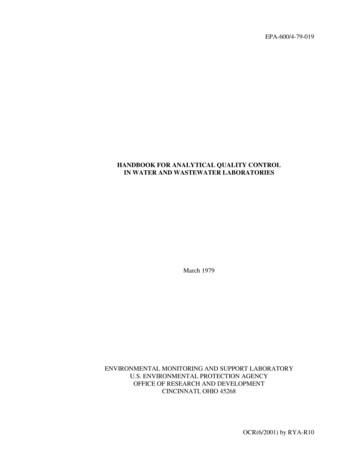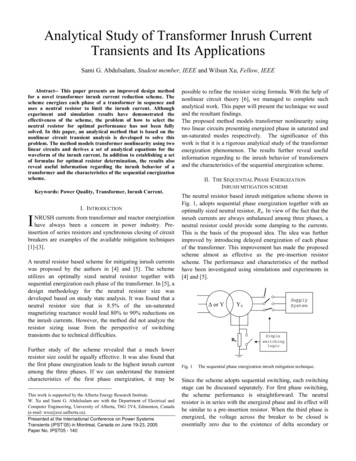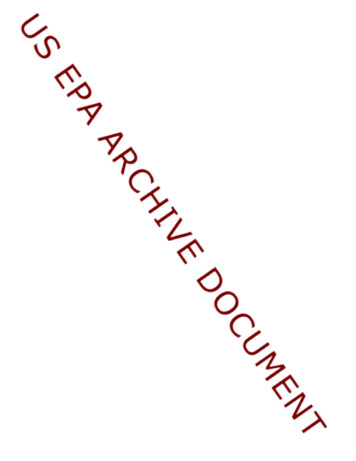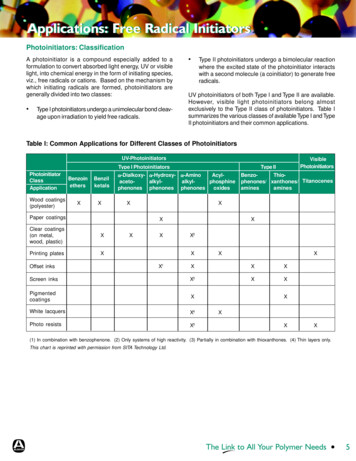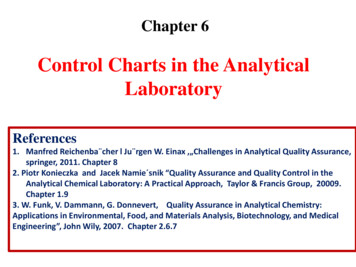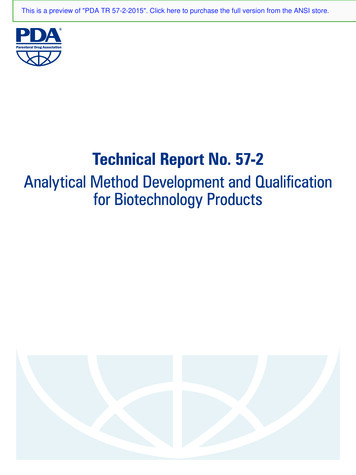
Transcription
This is a preview of "PDA TR 57-2-2015". Click here to purchase the full version from the ANSI store.Technical Report No. 57-2Analytical Method Development and Qualificationfor Biotechnology Products
This is a preview of "PDA TR 57-2-2015". Click here to purchase the full version from the ANSI store.PDA Analytical Method Development and Qualification of Biotechnology Products TechnicalReport TeamAuthorsMelissa J. Smith, MJ Quality Solutions, (Chair)Dwayne Neal, Emergent BioSolutionsFlorence Baudoux, GlaxoSmithKline BiologicalsPhillip Ramsey, Emergent BioSolutionsMarta Germano, Janssen Pharmaceutical Companiesof Johnson & JohnsonMichael Rooney, Ph.D., Jazz PharmaceuticalsJoachim Leube, Ph.D., CrucellZoran Sosic, Biogen IdecSheila Magil, Ph.D., BioProcess TechnologyConsultants, Inc.Rebecca Sendak, Ph.D., SanofiEarl K. Zablackis, Ph.D., Sanofi PasteurCarl Gustav-Millinger, Quality & QualimetricsConsultancy QQC ABContributorsRaphael Bar, Ph.D., BR ConsultingStephan O. Krause, Ph.D., MedImmuneDaoTian Fu, Ph.D., Livzon Mabpharm, Inc.Nadine M. Ritter, Global Biotech Experts, LLCKenji Furuya, Boehringer IngelheimJane Weitzel, Quality Analysis ConsultantsDISCLAIMER: The content and views expressed in this technical report are the result of a consensus achieved by theauthorizing task force and are not necessarily the views of the organizations they represent.
This is a preview of "PDA TR 57-2-2015". Click here to purchase the full version from the ANSI store.Analytical MethodDevelopment andQualification forBiotechnology ProductsTechnical Report No. 57-2ISBN: 978-0-939459-74-2 2015 Parenteral Drug Association, Inc.All rights reserved.Bethesda Towers4350 East West HighwaySuite 200Bethesda, MD 20814 USATel: 1 (301) 656-5900Fax: 1 (301) 986-0296E-mail: info@pda.orgWeb site: www.pda.org
This is a preview of "PDA TR 57-2-2015". Click here to purchase the full version from the ANSI store.Table of Contents1.0 INTRODUCTION 11.1 Method Lifecycle 21.2 Purpose and Scope 22.0 GLOSSARY OF TERMS 42.1 Abbreviations 63.0 METHOD DEVELOPMENT 73.1 Method Definition 73.1.1 Analytical Target Profile 93.2 Method Selection 113.2.1 Risk Assessment 123.2.2 Selection of Platform-Based Technologies 123.2.3 Conclusion of the Selection Process 133.3 Method Development and Optimization 133.3.1 Phased Approach 133.3.2 Risk Considerations 133.3.3 Design of Experiment 143.3.3.1 List and Description of Experiments 153.3.4 Execution of Development Activities 163.3.4.1 Samples and Standards 163.3.4.2 Known or Expected Impurities 173.3.4.3 Forced-Degradation Samples 183.3.4.4 Equipment 183.3.4.5 System Suitability 183.3.4.6 Robustness 193.3.5 Evaluation of Development Activities 203.4 Method Deliverables 203.4.1 Baseline and Best-Practice Deliverables 213.4.2 Documentation Deliverables 233.4.3 Physical Deliverables 244.0 METHOD QUALIFICATION 264.1 Overview 264.2 Method Development Package Assessment 294.2.1 Intended Use and Performance 294.2.2 Standard Operating Procedure 294.2.3 Physical Deliverables: Material andEquipment 304.2.4 Robustness 304.2.5 Readiness to Proceed 304.3 Method Qualification Plan or Protocols 304.3.1 Qualification Approach 304.3.2 Qualification Characteristics 314.3.2.1 Reference Standards 314.3.2.2 Specificity 314.3.2.3 Spiked Samples 324.3.2.4 Linearity and Range 324.3.2.5 Accuracy 324.3.2.6 Repeatability and IntermediatePrecision 324.3.2.7 Detection Limits and QuantitationLimits 344.3.2.8 Robustness 344.3.2.9 Stability-Indicating Assessment 344.4 Execution 354.5 Qualification Evaluation 354.5.1 Specificity 354.5.2 Accuracy, Precision, Linearity, and Range 354.5.3 Detection Limits and Quantitation Limits 364.5.4 Statistical Assessments and Practical vs.Statistical Differences 364.5.5 Qualification Excursions 364.6 Method Qualification Report 374.6.1 Standard Operating Procedure 374.6.2 Supportive Procedures 374.6.3 Data 384.6.4 System Suitability and SampleValidity Criteria 384.7 Conclusions and Deliverables 385.0 ANALYTICAL METHOD COMPARABILITY ANDANALYTICAL METHOD TRANSFER 456.0 METHOD LIFECYCLE MANAGEMENTCONTINUUM 467.0 CONCLUSION 488.0 REFERENCES 49
This is a preview of "PDA TR 57-2-2015". Click here to purchase the full version from the ANSI store.FIGURES AND TABLES INDEXFigure 1.1-1Method Lifecycle and its Links toProduct Development 2Figure 1.2-1 Table of Contents Map 3Figure 3.0-1 Method Development Process 7Table 3.1-1 Overview of Method Definition Process 8Table 3.1-2 Points to Consider for Method Definition 9Table 3.2-1 Inputs and Outputs of MethodSelection Process 11Figure 3.3.2-1 Risk Assessment Process Map 14Figure 3.3.3.1-1 Iterative Method DevelopmentProcess 15Table 3.3.4.6-1 Fractional Factorial Design: Factors,Levels with Result from Each Run,and Factor Effect p-values 19Figure 3.3.4.6-1 Normal Plot Robustness FactorAssessment 20Table 3.4.1-1Baseline and Best Practices forDeliverables of a Developed Method 22Figure 3.4.2.1-1 Documentation Deliverables 24Figure 3.4.3-1 Physical Materials Deliverables 25Figure 4.1-1 Models of Qualification 27Table 4.3.2.6-1 Sample IP Matrix 33Figure 4.3.2.6-1 Sample Nested Design forIP for Day 1 33Table 4.3.2.6-2 Sample Restricted MaximumLikelihood Variance ComponentEstimates for IP Matrix 34Table 4.7-1 Evaluations and Deliverables forAMD and AMQ 39Figure 6.0-1 Development and QualificationLifecycle Deliverables 46
This is a preview of "PDA TR 57-2-2015". Click here to purchase the full version from the ANSI store.1.0 IntroductionThis technical report provides practical, risk-based guidance for the development and qualificationportions of the analytical method lifecycle for biotechnology products. It is a companion report toPDA Technical Report No. 57: Analytical Method Validation and Transfer for Biotechnology Products.Method development begins with defining the requirements for the analytical method. Based on theintended use and related requirements of the method, an analytical platform is selected in concertwith the appropriate materials and equipment. A method is defined through method optimization,with consideration of the final requirements of the method (e.g., sensitivity and specificity). Thedevelopment of a method typically leads to, but does not necessarily finish with, its qualification,which is a documented assessment of method performance (1). This process is one means to helpensure that the method is scientifically sound (specific, sensitive, accurate, and reproducible) and issuitable and reliable for the specified purpose (2-4). Method performance may also be assessed byother means, including trending of assay controls during routine method use.The development process depends on the use of appropriately detailed documents that describe theanalytical method. Operational and maintenance procedures for equipment should be available toensure proper functioning with respect to the intended use and phase of product development (4-7).Analytical method development (AMD) and analytical method qualification (AMQ) are typicallyiterative processes whereby the method is optimized, tested for its suitability (i.e., ability to meettarget criteria for performance characteristics, such as precision and accuracy) through qualificationstudies, and potentially further optimized based on the qualification results.The analytical target profile (ATP) is discussed in further detail in the body of this technical report asa potential means to manage AMD and AMQ. The ATP is comprised of the concepts of intended use,expected performance; measured critical quality attributes (CQAs), identified critical performanceparameters, and completed iterative performance assessments. It can, therefore, be considered thestructural framework for the method development and qualification process as well as for the rest ofthe method lifecycle continuum, including validation and routine use (8).Qualification of an analytical method typically proceeds in a phase-appropriate manner commensuratewith the intended use of the method. In other words, a more extensive evaluation of methodperformance or qualification may be performed to support a Phase II clinical study than was used fora Phase I study, with both qualification activities being broadly based on the elements of ICH Q2(R1)guidance (6). The phase-appropriate guidance documents describe the qualification and validationactivities recommended for release and stability methods in support of a particular clinical phase (2,3).For other methods, such as characterization methods, qualification can be the end goal in the methodlifecycle. Formal method qualification is not a regulatory requirement prior to method validation, butit offers one means of ensuring method suitability and ability to satisfy the defined requirements (e.g.,in the ATP) and to support a successful validation.The intended use of analytical methods may change during the product development process andmay affect the ATP, method requirements, and method performance expectations. AMQ provides anoption to ensure the suitability of a method’s use for the release of early-phase or midphase clinicaltrial material without generating formal and prospective analytical method validation (AMV) studies.Technical Report No. 57-2 2015 Parenteral Drug Association, Inc.1
This is a preview of "PDA TR 57-2-2015". Click here to purchase the full version from the ANSI store.1.1Method LifecycleThe method lifecycle is the time from identification of the need for an analytical method throughmethod retirement, including periodic reassessments of and updates to the method. This lifecycleis tied to the product lifecycle in that the status of the method must be assessed in the context ofwhether the product is in the early stages of clinical development or is commercially approved. Animportant part of the method lifecycle is to ensure that at each stage, the method is assessed andfound ready to proceed to the next step. A schematic of the development and qualification elementsof the lifecycle, which are detailed within this report, is provided in Figure 1.1-1, which also showsthe link to validation, as detailed within PDA Technical Report No. 57.Increase in method understanding through development,qualification studies and/or information fromroutine testing (controlcharts, etc.)Analytical method transferAnalytical methoddevelopmentPreclinicalDevelopmentAnalytical methodqualificationPhase 1Analytical methodvalidationPhase 2Phase 3NDA/BLAfilingmethod lifecyclemanagementPost-approvalClinical developmentFigure 1.1-1 Method Lifecycle and its Links to Product Development1.2 Purpose and ScopeThis technical report covers method development and qualification for biotechnology products.The content that follows describes the method development and qualification portions of the lifecyclethat often lead to method validation, which is outlined in PDA Technical Report No. 57: Analytical MethodValidation and Transfer for Biotechnology Products and ICH Q2(R1) (6,9). This report also delineates thecommonalities and differences between qualification and validation, the various models for executionof qualification, and which of these models comprise the best practices of industry. The documentfurther recognizes that terms such as “qualification” may be commensurate with phase-appropriatevalidation within certain company systems and regulatory environments (1). This report includesguidance for AMD and AMQ studies, such as risk-based strategies and priorities; ATP and quality-bydesign (QbD) concepts; target performance criteria; and modern quality expectations, such as thosepresented in ICH Q8-10 guidelines (10-12).2 2015 Parenteral Drug Association, Inc. Technical Report No. 57-2
Sheila Magil, Ph.D., BioProcess Technology Consultants, Inc. Carl Gustav-Millinger, Quality & Qualimetrics Consultancy QQC AB Dwayne Neal, Emergent BioSolutions Phillip Ramsey, Emergent BioSolutions . Jane Weitzel, Quality Analysis Consultants DISCLAIMER: .


